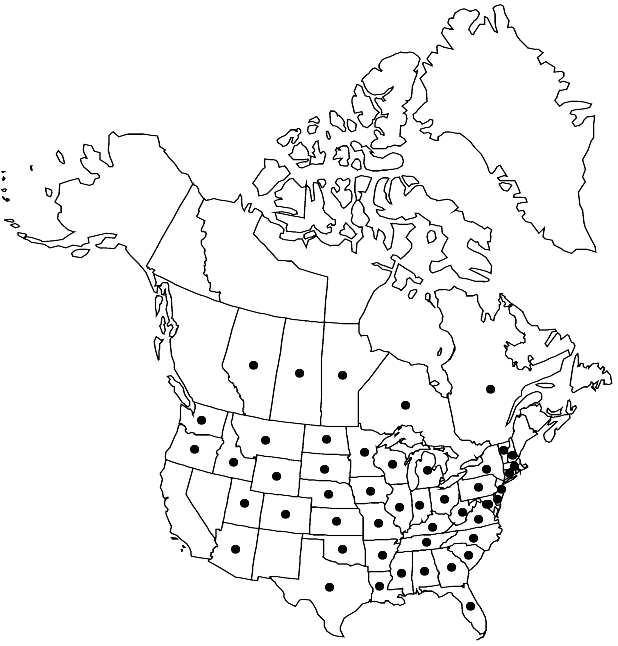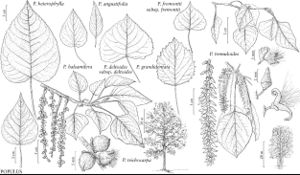Populus deltoides
Arbust. Amer., 106. 1785.
Plants to 55 m, 35 dm diam.; moderately to strongly heterophyllous, (often 2 or more trunks near base). Bark light brown, deeply furrowed. Branchlets yellow-brown, becoming tan by third year, round or 5-angled, coarse or not, (1–)2–3.5(–6) mm diam., glabrous or thinly long-hairy. Winter buds greenish yellow, glabrous or stiffly hairy, resinous (resin yellow, moderately fragrant); terminal buds (6–)8–15(–21) mm; flowering buds separated on branchlets, (8–)14–20(–28) mm. Leaves: petiole distally flattened at right angle to plane of blade, (1–)3–8(–13) cm, about equaling blade length, (glabrous); blade broadly triangular-ovate, (1–)3–9(–14) × (1.5–)3–9(–16.5) cm, w/l = 4/5–6/5, base truncate to cordate or broadly cuneate, basilaminar glands 0–6, round or tubular, margins translucent, ciliate, apex abruptly short- or long-acuminate, surfaces grayish green to bright green, glabrous (or visibly pilose only at emergence); preformed blade margins coarsely crenate-serrate midblade, teeth (3–)5–15(–30) on each side (graded, rounded), sinuses (0.4–)0.7–5(–7) mm deep; neoformed blade margins crenate-serrate, teeth (10–)25–40(–55) on each side (graded), sinuses (0.1–)0.5–1.5(–3) mm deep. Catkins loosely (3–)15–40(–55)-flowered, (0.7–)5–18(–24 in fruit) cm; floral bract apex deeply cut, not ciliate. Pedicels 1–13(–17 in fruit) mm. Flowers: discs saucer-shaped, not obviously oblique, entire, 1–3(–4) mm diam.; stamens 30–40(–55); anthers truncate; ovary (3- or)4-carpelled, ovoid; stigmas 2–4, platelike, spreading. Capsules ovoid, (4–)8–11(–16) mm, glabrous, (3- or)4-valved. Seeds (3–)7–10(–23) per placenta. 2n = 38.
Distribution

Alta., Man., Ont., Que., Sask., Ala., Ariz., Ark., Colo., Conn., D.C., Del., Fla., Ga., Idaho, Ill., Ind., Iowa, Kans., Ky., La., Mass., Md., Mich., Minn., Miss., Mo., Mont., N.C., N.Dak., N.H., N.J., N.Mex., N.Y., Nebr., Ohio, Okla., Oreg., Pa., S.C., S.Dak., Tenn., Tex., Utah, Va., Vt., W.Va., Wash., Wis., Wyo., n Mexico.
Discussion
Subspecies 3 (3 in the flora).
Populus deltoides hybridizes with P. fremontii, the other native species of sect. Aigeiros, in the Colorado Plateau region (Arizona, New Mexico, and Utah) and trans-Pecos Texas. These hybrids involve P. deltoides subsp. wislizeni with both subspecies of P. fremontii and are difficult to distinguish because the parent species are so similar. They have shallowly cup-shaped discs 3–5 mm diam., pedicels 4–6 mm, and, usually, sparsely pubescent branchlets. Populus deltoides hybridizes also with three native members of sect. Tacamahaca. All three hybrids, P. ×generosa A. Henry (P. trichocarpa × P. deltoides), P. ×jackii Sargent (P. balsamifera × P. deltoides), and P. ×acuminata Rydberg (P. angustifolia × P. deltoides), are distinguished from P. deltoides by their buds with reddish resin, fewer triangular leaves with finer teeth, less flattening of the petiole, and a distinctly paler, slightly whitened abaxial leaf surface (J. E. Eckenwalder 1984). Individual hybrids have distinct ranges corresponding to their parental regions of sympatry and may be distinguished from each other by relative leaf width (less than two-thirds as wide as long in P. ×acuminata and more than two-thirds as wide as long in the other two) and base shapes (cordate in P. ×jackii and cuneate in the other two). Hybrids with members of the other two sections are rare or unknown. Hybridization with P. heterophylla (sect. Leucoides) is apparently rare and very local in South Carolina, even though the region of sympatry of these two species occupies essentially the entire range of P. heterophylla. Reported hybrids with P. tremuloides (sect. Populus) named as P. ×bernardii B. Boivin (T. C. Brayshaw 1965b; B. Boivin 1966b) are actually individuals of P. ×jackii (Eckenwalder).
Two related members of sect. Aigeiros, Populus nigra Linnaeus and P. ×canadensis Moench, are often planted as staminate clones, often persist after cultivation, and spread by root suckers but never become naturalized. Most individuals of Eurasian P. nigra cultivated in North America are Lombardy poplars (cv. Italica), an unmistakable, narrowly columnar, staminate clone with heavily buttressed trunk, rhombic preformed leaves, and triangular-ovate neoformed leaves broader than wide. This tree has been known since the eighteenth century and is widely (over-)planted throughout the temperate portion of the flora area as an accent tree. It hybridizes sporadically here with the three native balsam poplars, P. angustifolia, P. balsamifera, and P. trichocarpa; hybrids are discussed under those species. A rare hybrid with P. fremontii (P. ×inopina Eckenwalder) apparently originated from an uncommon pistillate tree of P. nigra (J. E. Eckenwalder 1982). It resembles P. fremontii in leaf shape but has dark reddish brown winter buds.
Populus nigra and P. ×canadensis are both staminate and are similar in having winter buds usually 12+ mm with a balsamic fragrance and orange-red resin. The branchlets are round and bright orange-brown to reddish brown in the first year, turning tan by the third year. The petioles are distally flattened at a right angle to the plane of blade. The margins of the leaf blade are translucent and ciliate; the leaf surfaces are glabrous or glabrate to pubescent but not tomentose. The catkins usually have more than 15 flowers, (4–)7–15 cm. The floral disc is entire, persistent, broadly cup- or saucer-shaped, and not obviously oblique. The anthers are usually truncate. The 2-carpelled ovary is ovoid to spherical and the 2–4 stigmas are expanded. The floral bracts are not ciliate and are glabrous abaxially. The two taxa differ in that P. nigra has branchlets that are nearly parallel, leaf blades without basilaminar glands, preformed blade margins with sinuses no more than 1.2 mm deep, and 12–20(–30) stamens; P. ×canadensis has divergent branchlets, branching at 50º or more, leaf blades with no more than 1 basilaminar gland, preformed blades with the base broadly cuneate and apex gradually acuminate, and (15–)20–30 stamens.
Populus ×canadensis (P. ×euramericana Guinier [illegitimate name]; B. K. Boom 1957) is an intercontinental hybrid that first arose spontaneously between P. deltoides and P. nigra after the former was introduced into Europe in the late seventeenth century. Deliberate new hybrids of this parentage are one of the mainstays of Europe’s growing commercial poplar plantations. They are also important in eastern North America but are often replaced by P. ×generosa (P. trichocarpa × P. deltoides) in commercial plantations in British Columbia, Oregon, and Washington. Only one clone is commonly, and very widely, grown horticulturally, the Carolina poplar (‘Eugenei’), a staminate clone with a fairly narrow habit inherited from its staminate parent, the Lombardy poplar. It is often confused with P. deltoides, with narrower preformed leaves, often slightly longer than wide, with more numerous, smaller teeth, and with bases obtuse or rounded, rather than truncate or subcordate. It differs further from P. deltoides subspp. deltoides and monilifera in having 0–1 basilaminar glands rather than 2–6.
Selected References
None.
Lower Taxa
Key
| 1 | Leaf blades: apices long-acuminate, bases usually with 2 round basilaminar glands; pedicel lengths uniform, 1-6(-8 in fruit) mm. | Populus deltoides subsp. monilifera |
| 1 | Leaf blades: apices short-acuminate, bases usually with 0 or 3-6 tubular basilaminar glands; pedicel lengths progressively graded or uniform, 1-13 (-17 in fruit) mm | > 2 |
| 2 | Winter buds usually glabrous; leaves: basilaminar glands 3-6, abaxial surface pilose at emergence; neoformed blades: lengths usually distinctly greater than widths; pedicel lengths graded (shorter from base to apex). | Populus deltoides subsp. deltoides |
| 2 | Winter buds pubescent; leaves: basilaminar glands 0, abaxial surface glabrous at emergence; neoformed blades: lengths usually less than widths; pedicel lengths uniform | Populus deltoides subsp. wislizeni |
